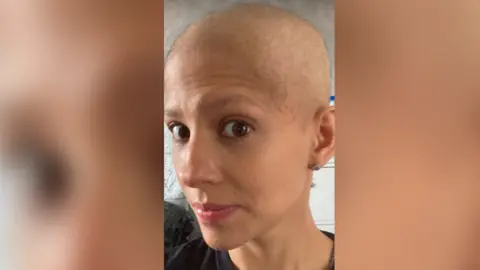I was told I couldn’t get an Afro wig after chemo

 anastasia cameron
anastasia cameronFrom the age of seven Anastasia Cameron was turned away from hairdressers because she was told they “don’t do Afro hair”.
The 39-year-old woman, who was diagnosed with breast cancer in 2021, said little had changed when she needed a wig after chemotherapy as an adult.
“It was horrible, they basically said I couldn’t have African hair,” she said. “You’re in a traumatic situation after being diagnosed and dealing with physical changes – but I was isolated again and had to manage the situation on my own.”
This experience took him back to his childhood when he was sent away from salons or made fun of by his peers after getting cuts by inexperienced stylists.
 anastasia camerson
anastasia camerson“At that moment I felt there was something wrong with me,” he said.
“The stigma I endured for a long time – that traumatizes you.”
When Ms. Cameron needed wigs of the appropriate texture after cancer treatment, they were not available.
But changes to the NHS Wales contract now mean wig suppliers will have to offer a wider range for different ethnic communities.
This inspired Ms Cameron, a hairdresser and wig maker from Rouse, Vale of Glamorgan, to bid for one of the NHS Wales contracts herself, meaning she now ensures cancer patients have the option to choose their Was not close.
He said there is still a huge skills gap between hairdressers who are not trained to cut his type of curly or Afro-textured hair.
“I recently went to get my first haircut after chemotherapy and I had to talk to the person because they didn’t know how to do that. I have the experience of being able to do that, but I shouldn’t have to do that. “
 anastasia cameron
anastasia cameronThis gap in appropriate care is a familiar theme for Denise Mayhew, ambassador for cancer charity Black Women Rising.
But inequalities are also seen within health care. His own treatment was excellent, he said, but it is not ideal.
“We may all be one human race, but we are certainly not treated the same,” said the 42-year-old blood cancer survivor. multiple myeloma In 2018.
 amanda akokhia
amanda akokhia“You have people coming to your medical team who are saying ‘Please treat me like a white woman so I can live.’ It’s heartbreaking.”
She explained that “myths and taboos” often create barriers to diagnosis, with women being portrayed as “black and strong”, meaning their pain is dismissed.
Cultural attitudes and religious beliefs within communities may make people hesitant about chemotherapy, although work is being done to “try to change the narrative”.

Breast cancer surgeon Zoe Barber admitted that “the fear of being dismissed by the doctor was absolutely justified”.
Women in those groups are typically diagnosed at a later date, resulting in more aggressive treatment and worse prognosis, she said.
Ms. Barber provided additional support after treatment was not always sufficient.
The prostheses offered after mastectomy “until quite recently came in either white or light peach and if you’re a woman who doesn’t have fair skin, it’s too ‘other’ for you”.
“As physicians we must advocate for those women as well. I think it’s still important that we recognize that we are still failing those women and there is still a lot of work to be done.”
 anastasia cameron
anastasia cameronJudy Rice of Tenovus Cancer Care said the lack of data on patient ethnicity remains a “significant barrier to equitable health care.”
“We have called for data on patients’ ethnicity to be collected because our research has shown that it is not routinely collected, despite orders to do so,” he said.
“We understand that activity is on the horizon, but progress has been very slow.
“Not only can this data inform tailored treatment pathways, but it can also highlight underrepresented groups in research and clinical trials, disparities in screening, and the need for essential services such as hair replacement during treatment “
The Welsh Government said it took health inequalities “very seriously” and had implemented “a number of improvements to data collection and analysis”.
It said it would continue to work with NHS Wales to “determine how we can get data on ethnicity” so that data is available when people are accessing healthcare.






